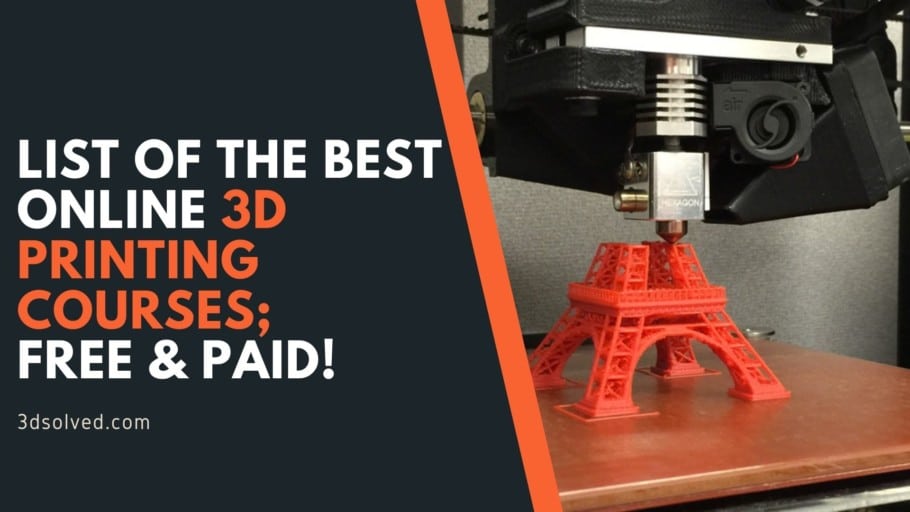Getting your first 3D printer is exciting, but once you’re done putting it together it can be quite hard to figure out how to actually get it to print without any hiccups, not to mention how to create your own 3D models.
So, in this article I will be going over the best courses I found online, both about how to know the ins and outs of your 3D printer as well as the software used for 3D design.
So, without any further ado, let’s get started with my selection of the best free ones:
- Free 3D Printing Design Courses
- Complete beginner's guide to 3D printing (By Teaching Tech)
- Beginner 3D Printing Class (Instructables)
- Tinkercad Tutorial Series (By PromoAmbitions)
- Skillshare Courses (One or Two-month Free Trial)
- Fusion 360 for 3D Printing 2021 (By Austen Hartley)
- Introduction to 3D Printing: An Easy Start to Your First 3D Design (By Lauren Slowik)
- 3D Printing: Solving Problems Through Product Design (By Lauren Slowik)
- Fusion 360 for 3D Printing Series (By Vladimir Mariano)
- Foundations of Blender: Jewelry Design in 3D (By Gesa Pickbrenner)
- Paid Courses
- 3D Printing from Start to Finish ($12.99)
- The 3D Printing Revolution (Free – $49)
- Complete Blender Creator: Learn 3D Modelling for Beginners ($12.99)
- The Complete 3D-Printing Course – Masterclass ($12.99)
- 3D Printing and Tinkercad Crash Course ($19.99)
- Design For 3D Printing | Fusion 360 Masterclass ($12.99)
- Conclusion
- Check out our recommended products section
Free 3D Printing Design Courses
Here I will list a couple courses I found on YouTube when I was first starting out as well as some additional ones I found on Skillshare, which is a paid platform but you can still use for free by taking advantage of their free trial.
Complete beginner’s guide to 3D printing (By Teaching Tech)
Difficulty Level: Beginner.
In this guide you’ll learn all the essentials of 3D printing (Everything is shown on an Ender 3, which is the most common 3D printer out there, but 99% of the information applies to all other 3D printers out there).
This guide goes over the assembly process of the printer, understanding how the printer works, how it’s powered and what all the cables and the mainboard do, how to Bowden-style extruder works (since the Ender 3 doesn’t feature a Direct Drive system), how to make the necessary adjustments to the carriages and the belts so that they move properly along the different axis, and many more technical things that you should learn in order to fully understand how the printer works and to properly take care of it.
You will also learn how to level the bed, which is by far the most difficult part of the whole process when you don’t know how to do it, as well as how to use the Slicing software to be able to convert 3D models into a language that the printer can “understand”.
You will need to do a test print to see if the bed is properly leveled (which is provided in the video description), but if you want to find more free 3D models to print on your brand-new printer, then check out our own search engine that is designed to search through all the different databases to find you the best design possible!
This guide is more technical than the next ones you will find on this list and I included it because I think that anyone who just got their first 3D printer should have the basic understanding of how the components work to be able to learn to troubleshoot and fix issues, as well as preventing them.
Who this course is for: Absolute beginners who want to learn how a printer works, what each component does, how to set it up, level the bed, and use the Slicer software.
Check it out here: Complete beginner’s guide to 3D printing.
Other useful 3D Printing YouTube Channels
Beginner 3D Printing Class (Instructables)
Difficulty Level: Beginner.
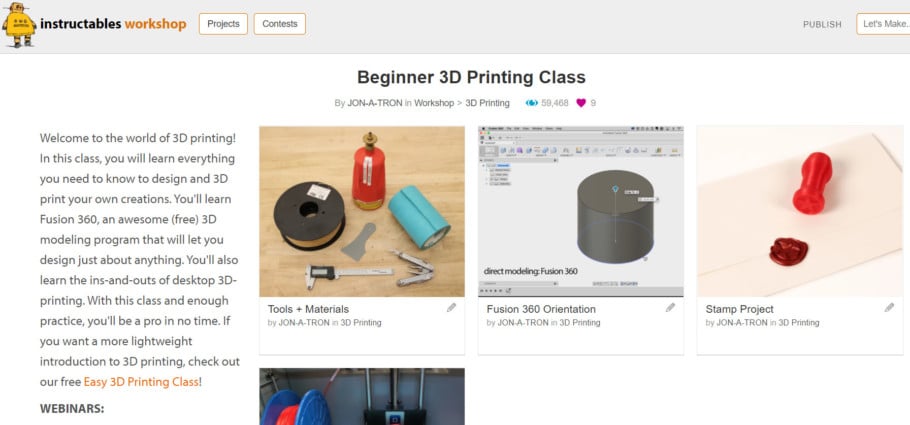
If you’re an absolute beginner, someone who needs a hand figuring out the tools they need as well as what different software to use, and even how to take a model and slice is so that it can be printed, then this free course covers it all!
You will be introduced to the 3D printing workflow in general, what types of CAD software there are (3D design software to make your own models), what Slicers are and how they work (a slicer is designed to horizontally “slice” the print in different layers so that the printer knows what to print in each layer), a short example list of what 3D printers there are, and another list of tools you might need (in most cases, you don’t need everything on there).
In addition to this, you will learn how to prepare a printer for 3D printing (Bed leveling, cleaning the bed, Loading and unloading Filament, preheating the printer, and more).
Lastly, you will be taught how to make a Stamp in Fusion 360 yourself, which you can then print and use.
This course is very well laid out and really does cover all the basics, plus it’s filled with screenshots which makes following the different steps a breeze. However, it is really aimed at absolute beginners.
Who this course is for: Absolute beginners who are just getting started with 3D printing.
Check it out here: Beginner 3D Printing Class.
Tinkercad Tutorial Series (By PromoAmbitions)
Difficulty Level: Beginner.
Tinkercad is a free browser-based CAD (Computer Aided Design) software that is extremely useful to help you learn all the ins and outs of 3D design, and while it may not be as powerful as something like Fusion 360, it’s definitely good enough to let you create some great-looking and functional 3D prints, in fact, the first couple prints I ever created were made on Tinkercad.
Out of all the Tinkercad courses I was able to find, even paid ones, this is the one that I felt offered the best information overall and it’s even taught in a very methodical and easy-to-understand manner.
It’s a total of 6 videos of about 20 min each, and you will learn how to navigate Tinkercad’s interface, how to create objects, adjust their size, how to see your design in the “Blocks” mode ( looks like LEGO pieces), and essentially how to create fairly complex 3D objects.
Lastly, you’ll learn how to export your models so that they can be Sliced and then printed.
Who this course is for: Beginner 3D printer and 3D design enthusiasts that want to learn the basics of 3D design with a free and user-friendly software.
Check it out here: Tinkercad Tutorial.
Skillshare Courses (One or Two-month Free Trial)
Skillshare isn’t a free platform, however, you can get a month, or even two, for completely free which you can cancel at any time without getting billed, which is why if you have never subscribed to Skillshare, you can do so now for free and complete as many courses as you’d like before the free trial runs out.
It’s worth noting that there are tons of courses available on Skillshare, but I’d recommend skipping some of the introductory ones because they don’t really teach you anything and just go over what 3D printing can do, so don’t waste your time with those.
Here are the ones that I found to be the best, and yes, I sat through all of them:
Fusion 360 for 3D Printing 2021 (By Austen Hartley)
Difficulty Level: Beginner, Intermediate.
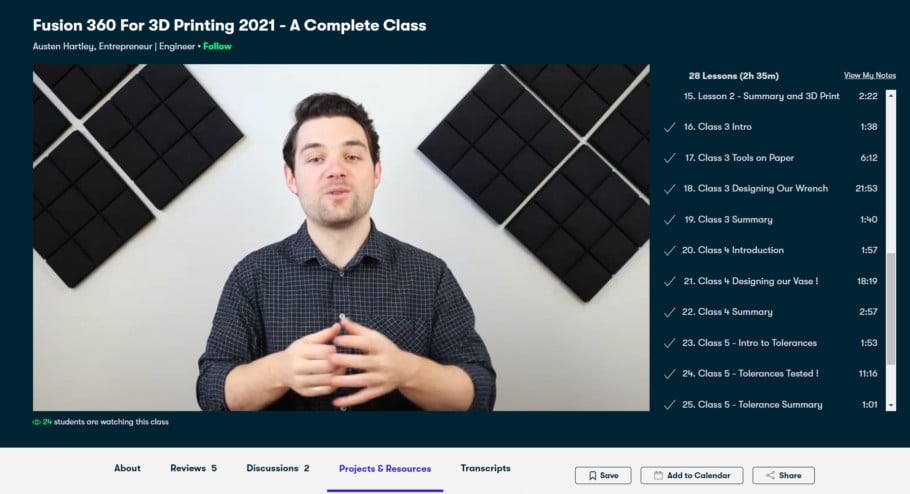
Fusion 360 is a design software that’s used to create 3D models, and if you want to be able to create your own 3D designs, then learning how to use such a software is absolutely essential.
This class features a total of 25 lessons, which is far more than most other courses on Skillshare and here you’ll learn how to set up Fusion 360 and the entire workspace before starting the first design.
You will learn how to create a basic sketch, how to adjust its dimensions, how to use the trim tool, the fillet tool, how to use sketch dimensions and rectangular patterns, using the “constraints” section of Fusion 360, how to extrude the sketch to make it 3-dimensional, and a lot more.
This tutorial becomes gradually more advanced and you’ll learn how to create a pencil holder, a wrench and lastly, a Vase, and all the different tools in the software you need to make them.
What I like about all of these classes is that Austen (the teacher) emphasizes a lot of creating good habits when learning to use the software, which in the long run translates into you being more efficient, and since he’s an engineer, he also provides some important information on how to make a model stronger.
Lastly, you will learn about tolerances (difference of two objects that need to fit together and how tight we want that fit to be), how to test them, and what tolerances to use.
Out of all the lessons on Skillshare, I think that this one is the most useful since it teaches all the basics but also some more advanced concepts in an easy-to-understand manner!
Who this course is for: Anyone who is interested in learning how to design their own prints and not just download them from the web.
Check it out here: Fusion 360 for 3D Printing 2021.
Introduction to 3D Printing: An Easy Start to Your First 3D Design (By Lauren Slowik)
Difficulty Level: Beginner.

Contrary to the previous lesson I just linked, this one goes over all the basics, even telling you how a 3D printer works, what additive manufacturing is, the basic equipment you might need (this really depends on what you’re planning to do), and then the teacher also explains a bit how 3D printing using powdered nylon works, but this isn’t something that most enthusiast makers will ever consider doing, so you can just skip that part.
Now, this course focuses on one thing mainly which is creating your own sketch on a piece of paper, taking a picture of it and importing it into your 3D design software, which in this course is Tinkercad (Free browser-based CAD).
If you’re someone who knows how to draw, unlike me, and who can create cool-looking designs with just a pen and a piece of paper, then this course will show you how to take those sketches and transform them into real-life prints.
It is worth noting that in this course they try to pitch you their 3D printing service called Shapeways, but you can just learn the information and then print your own models out yourself.
Who this course is for: People who want to be able to print the sketches they made on a piece of paper.
Check it out here: Introduction to 3D printing.
3D Printing: Solving Problems Through Product Design (By Lauren Slowik)
Difficulty Level: Beginner.

This is another course by the same teacher of the previous one I just mentioned, and here you will learn how to sketch out your ideas on a piece of paper first to get a good grasp of how the model should look before you actually move over to the design software.
Note: Try to measure everything in the sketching phase so that once you move into the design software you have all the measurements ready to go!
It’s also worth noting that the software used in this video is Autodesk 123D, which is no longer available, but you can use Fusion 360 for free, Tinkercad, or any other CAD software out there.
What I liked about this course, although it’s a fairly basic one, is that you will learn how to design your own functional 3D model in just a couple minutes and how to print out various different iterations until your design comes out the way you want it.
It’s not the most “information-packed” course out there, but it’s strictly aimed at beginners who want to learn how to design their own 3D prints.
Who this course is for: People who want to learn how to create extremely simple 3D models.
Check it out here: 3D Printing: Solving Problems Through Product Design.
Fusion 360 for 3D Printing Series (By Vladimir Mariano)
Difficulty Level: Beginner.
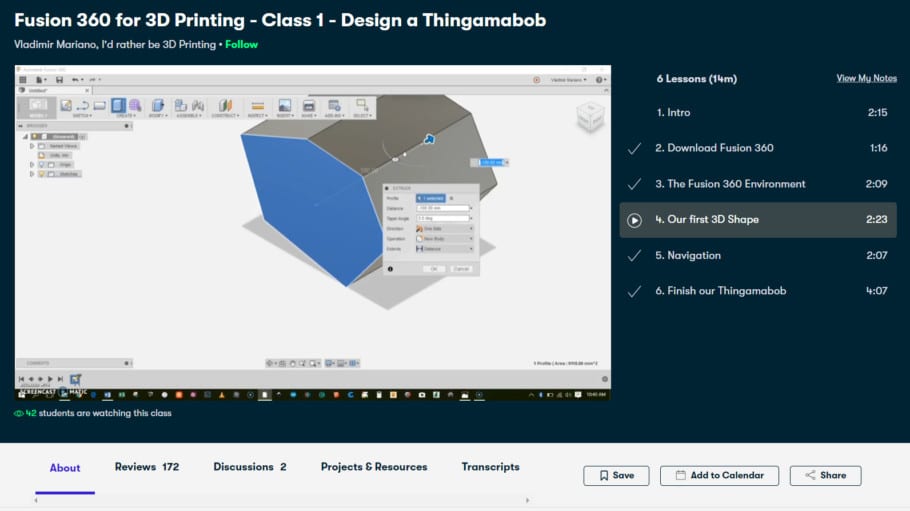
If you want a quick and easy way to learn how to design 3D objects in Fusion 360, then the courses made by Vladimir Mariano might interest you since you’ll learn how to create specific objects in an easy-to-follow manner.
He offers a total of 11 classes in his Fusion 360 series where you’ll learn how to create designs such as a Hair Comb, a Taco Stand, a Bottle Opener and more. However, he also has a couple more classes available which you should definitely check out.
I found his courses to be straight to the point without having any added fluff, which is the way I like to learn, plus he doesn’t explain all the concepts first without showing you what they do, but rather let’s you see the entire design process and explains what everything does as he’s designing the model.
I do have to say, however, that the information isn’t as in-depth as the first course I linked, but he does offer close to 15 courses in total which ends up providing a lot of value nonetheless.
Who this course is for: Beginners who want to learn by doing, essentially learning what every tool in Fusion 360 does once they actually need to use it.
Check it out here: Fusion 360 for 3D Printing.
Foundations of Blender: Jewelry Design in 3D (By Gesa Pickbrenner)
Difficulty Level: All Levels.

If you’re the proud owner of a resin 3D printer, then you probably thought about making some 3D printed jewelry with it! Well, here’s a course about just that!
First let me preface this by saying that Blender is a bit more confusing than something like Fusion 360, even the teacher mentions this in the course. However, she goes over all the basics that you need to know in order to be able to make your own jewelry, like understanding the interface, some important keybinds and shortcuts, etc.
You will learn how to sketch out the model on paper and how to import that same sketch into blender to use it as a reference, and then how to create different ring bands, the diamonds that may go with the jewelry, and more.
Lastly, you’ll learn how to render the file and to export it so that it can be sliced and then printed on your resin printer.
Who this course is for: Resin printer owners who want to create jewelry.
Check it out here: Foundations of Blender: Jewelry Design in 3D.
Paid Courses
This section will be comprised of a couple premium courses, some of which I actually enrolled in and completed.
However, I’d recommend going through all the free ones first, especially the first one on the list before even considering enrolling in a paid course.
3D Printing from Start to Finish ($12.99)
Difficulty Level: Beginner.

This is a course that covers just about everything you need to know to get started and to have successful prints without too much hassle.
One quick note though; It doesn’t go over the assembly process and how to get everything set up.
The course starts out by telling you what 3D printing is and how it works, the different types of 3D printing (FDM and SLA) as well as their pros and cons, the different filament types and their properties, printing temperature, etc.
Then you’ll learn about what a Slicer does and the .gcode it creates (.gcode is what tells the printer how to print the object), as well as some other basic- yet important concepts, such as what layer height is, what a Skirt, a Brim and a Raft are and what they are used for (you can check out my post on that subject as well), what infill is and how it works, the different infill patterns, what supports are and why you may need them, and lastly what a perimeter/shell is.
After this, the course goes straight into the different settings you can use in your slicer to actually tweak the printer’s behavior, such as adjusting the retraction settings (how far the extruder pulls back the filament to prevent stringing), adjusting the print speed, etc.
Lastly, you will get a brief overview of how to use Simplify 3D, which is a Slicing software. However, this one requires you to purchase a license to use and there are many free ones out there like Cura that work just as well.
Who this course is for: Beginners who want a straight-to-the-point course that teaches all the basics in an easy-to-understand manner.
Check it out here: 3D Printing from Start to Finish.
The 3D Printing Revolution (Free – $49)
Difficulty Level: All Levels.
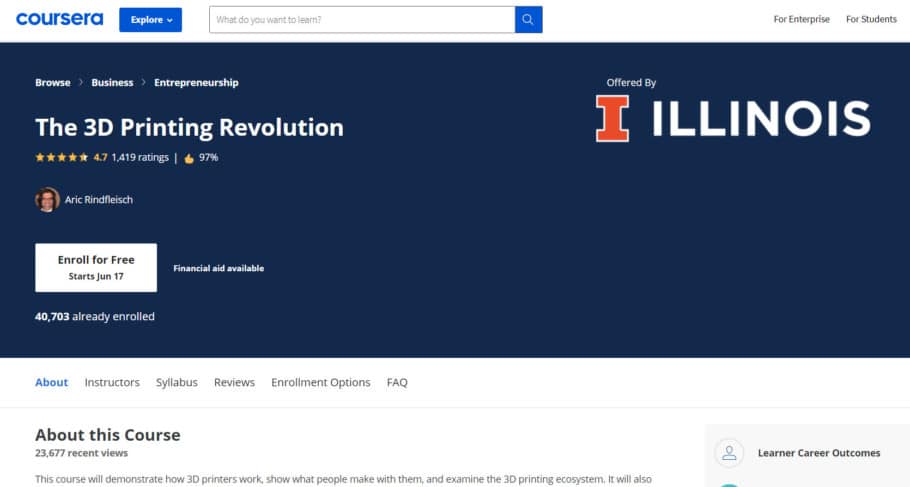
This is by far the most extensive course on this list and will take you multiple weeks to finish. The great thing is that you can get it for free (auditing the class), or you can pay for the course and get access to the quizzes and receive a certificate once you complete it.
It consists of 2 modules and here you will learn about the history of 3D printing, what it is and how printers work, the different materials and their costs, what printers to get and where to find them, as well as where to find free files to download (you can go back to our homepage to use out own search engine that will help you find free .STL files to download), and more.
This isn’t a course to strictly learn how to use a printer but rather one that talks about what 3D printing is, what it’s used for in the industry, its past as well as where it’s going, and engineering in general.
I included this course because even though it won’t teach you how to design your own models or how to setup your printer, it’s packed with information about the 3D printing technology and engineering which some might find really interesting.
Who this course is for: People with a general interest in 3D printing and Engineering.
Check it out here: The 3D Printing Revolution.
Complete Blender Creator: Learn 3D Modelling for Beginners ($12.99)
Difficulty Level: Beginner, Intermediate.

If you’re more interested in learning how to design using Blender than Fusion 360, Tinkercad, or any other CAD, then this course might tickle your fancy!
It’s got over 35 hours of content, which is rare for courses available on Udemy since they are mostly about one or two hours in length, and here you will learn all the basics of using Blender, understanding the ins and outs of the interface, and you’ll learn how to create complex 3D models in a practical manner.
The course covers all the basics and teaches you several techniques, from modeling, texturing, lighting and even animation (which might not be particularly important for people who want to create models to 3D print, but it might still be useful).
Lastly, the course gets updated and improved regularly. Also, they say it’s mostly a beginner course but I think that intermediates might also benefit from it.
Who this course is for: People with a general interest in 3D printing and 3D modelling (this courses focuses more on 3D modelling for gaming, but the information is still extremely useful for creating 3D prints).
Check it out here: Complete Blender Creator: Learn 3D Modelling for Beginners.
The Complete 3D-Printing Course – Masterclass ($12.99)
Difficulty Level: Beginner.
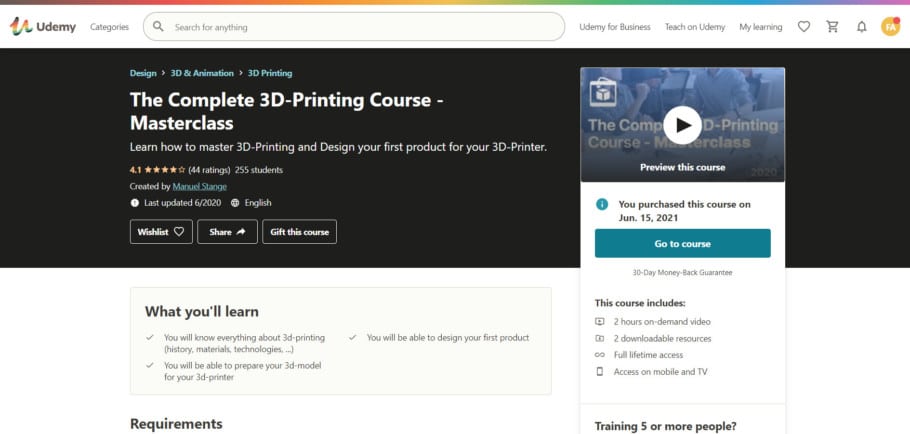
This is a 2-hour long course that’s divided into three different sections and teaches everything from what 3D printing is, some of its history, how 3D printers work, what different 3D printer technologies there are, as well as the different materials that you can print with, and what 3D printing is generally used for.
In addition to this, you will be introduced to Fusion 360 (3D Design software) and how to use it for free, where to download free 3D models, and even how to use a 3D scanner to scan real-life models and import them into your design software to be printed later on.
The whole Fusion 360 section is what I liked the most since it teaches you all the basics in short and easy-to-digest 2-minute-long videos where each one covers a different topic, such as Extruding the model, Fillets & Chamfers, Rendering, etc.
Lastly, you will learn how to use Netfabb, a software that allows you to do some additional things to your previously designed 3D model, such as repairing and cutting it, etc.
This course doesn’t really go into how to use Slicing software, such as Cura, but those are quite easy to use and a quick YouTube search will yield tons of results.
Who this course is for: Absolute Beginners who want to learn what 3D printing is all about and how to create basic 3D designs in Fusion 360.
Check it out here: The Complete 3D-Printing Course – Masterclass.
3D Printing and Tinkercad Crash Course ($19.99)
Difficulty Level: Beginner.
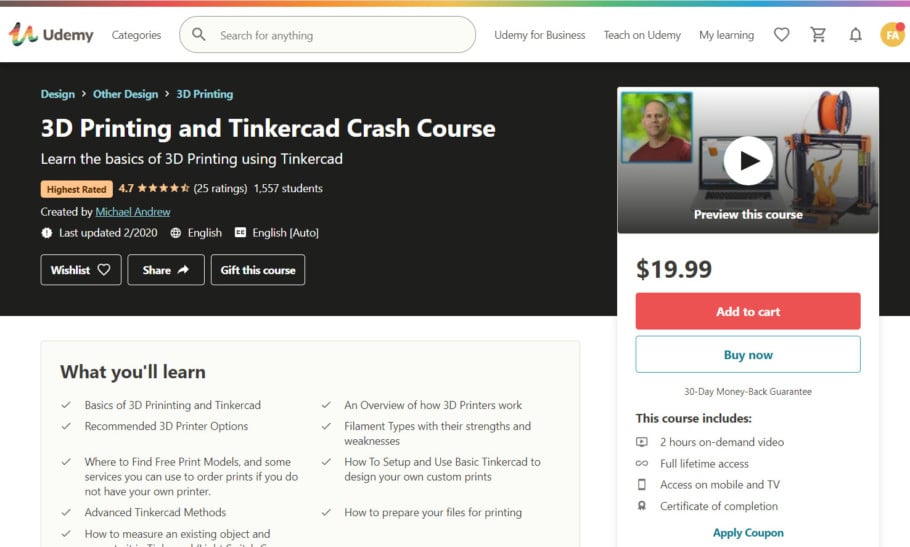
The easiest way to learn about 3D design, in my opinion, is through Tinkercad since it’s such a simple and intuitive software to learn.
This course focuses mainly on making sure that you learn the absolute basics so that you can comfortably create simple and semi-complex 3D models that you can then export and print on your 3D printer.
You will learn how to navigate the interface and how to use each of the different tools TInkercad has to offer, as well as how to adjust the dimensions of the model, and more.
Since Tinkercad’s design process consists of dragging and dropping different types of objects, such as cubes, circles, screws, etc., to create your end model, you need to learn how to modify those shapes and this is what this course is about.
In addition to this, it’s the only course so far that goes over post-processing, and while it doesn’t go into great detail of how to treat your finished prints, at least you’ll get an idea of how to do it.
Who this course is for: Beginners who want to learn about 3D design using a simple platform (Tinkercad).
Check it out here: 3D Printing and Tinkercad Crash Course.
Design For 3D Printing | Fusion 360 Masterclass ($12.99)
Difficulty Level: Beginner.

This course is a bit more advanced than the previous one I just listed since it’s based on Fusion 360, which is a much more powerful 3D design software than Tinkercad but also a bit harder to learn.
You will learn all the basics of how to navigate the interface and the workflow in general, and the course really goes in-depth here which is something that most of the other ones don’t.
After this the course teaches you how to create sketches from start to finish, how to extrude them, apply fillets & chamfers, and much more.
One of the advantages of this course is how short the lessons are, since you have 30 second- to one minute lessons per skill/tool making the whole thing simple to digest, plus if you need to revisit one section of the course it’s super easy since you don’t need to re-watch a 10 minute video in order to find that one short section that goes over chamfers.
Who this course is for: Beginner and Intermediate Fusion 360 users who want to learn to create 3D models to print.
Check it out here: Design For 3D Printing | Fusion 360 Masterclass.
Conclusion
I honestly would just start with the first course on this list as well as the first one in the “Skillshare” section, which again you can get for free by signing up to the free trial.
The first one by Teaching Tech, goes over all the basics, how to set up your printer, leveling the bed, etc., and the other course will teach you the fundamentals of designing objects in Fusion 360 which you can then print.
All the other courses are still great, but those two are my favorite ones!
I hope this information was useful!
Have a great day!
Check out our recommended products section

We created a recommended products section that will allow you to remove the guesswork and reduce the time spent researching what printer, filament, or upgrades to get, since we know that this can be a very daunting task and which generally leads to a lot of confusion.
We have selected just a handful of 3D printers that we consider to be good for beginners as well as intermediates, and even experts, making the decision easier, and the filaments, as well as the upgrades listed, were all tested by us and carefully selected, so you know that whichever one you choose will work as intended.
Error processing API data.
